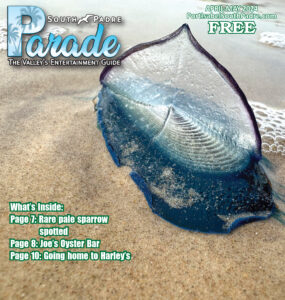By STEVE HATHCOCK
Special to the PRESS
Richard emailed me to ask if some heart shaped beans he found while vacationing on South Padre Island can be planted.
Hi Richard,
The seeds you found are Sea Hearts and originated from Costa Rica and were carried here by the Caribbean Currents. They are most often found along the beaches of Mexico, the Gulf Coast of Texas and the beaches of Florida, home of the pregnant “chads.”
A high climbing, woody, tropical vine from the Caribbean, called the escalera or monkey ladder, produces the seeds you found. The seed clusters form in four-to-seven-foot, twisted fruit pods. Each pod contains 10-15 seeds enclosed in individual compartments. These pods are too fragile to survive a long trip across water, but the seeds themselves have an extremely hard, outer shell capable of maintaining buoyancy for up to two years.
The vine, stretching from tree to tree, grows hundreds of feet above the jungle floor. Mature main stems, either flattened and ribbon-like or sinewy and spiraling, can measure more than a foot in diameter. Even the smallest stem is remarkably strong. It’s called the monkey ladder because it provides a sinewy vine highway through the canopy of the rain forest. Every year, the torrential rainy seasons flush millions of the heart-shaped beans down rivers and out to sea.
It probably took about a year for your beans to be caught off the Yucatan Coast by the Caribbean Current, swept into the Gulf of Mexico and deposited on the shores of sunny South Padre Island, Texas. A multitude of its brethren, still caught in a mighty current, may have continued their ancestral journey through the Straits of Florida before being drawn into the Atlantic. Where they float from there, is decided by prevailing winds and currents.
Once on land, the shell must be broken to allow fresh water to germinate the seed. Sea beans can be found year-round, but they are generally most abundant in March, or after a hurricane or a period of higher than normal tides. Walk along the tide line, right at the edge, until you come to a wash-out. Follow it back and hunt along the base of the dunes. This is where you will find a multitude of beans.
Yes, you can plant them, but keeping them alive in a cooler climate is a challenge. To germinate them, crack the hard-outer shell, then put the bean in a dish of shallow, fresh water. Change the water daily until you see a sprout. This usually will take about a week, but the time needed varies with each specimen. Plant the sprout in potting soil, and give it plenty of water and sunlight. In the cool months, you will want to bring it indoors and keep it away from cold drafts.
Christopher Columbus was fascinated with objects that drifted ashore in the Azores off the coast of Portugal. It has been said that the Sea Heart inspired his explorations to the west.
Early naturalists thought the Sea Hearts came from mysterious underwater plants whose origin was shrouded in legend and myth. It was not until 1889, when Prince Albert began his famous experiments with float, and bottle tests, that modern man realized how much ocean currents affect weather, commerce and the development of civilization itself. The Gulf Stream was shown to bring warm water to the Atlantic and to warm the coasts of England and Ireland both.
Ground seeds were prescribed for an amazing number of maladies including: contraception, constipation and snake bites and even reputedly used as an aphrodisiac. In Norway, a bitter tea was brewed from Sea Hearts to alleviate the pain of child birth. In England, beans carried by the North Atlantic Current, were given as teething rings to babies in hopes they would be given a protection, of sorts, if they took up a life with the sea. Necklaces are still made from them in the Caribbean, while beans found in Mexico, are often polished in rock tumblers before being painted and sold as souvenirs.
Want the whole story? Pick up a copy of the Port Isabel-South Padre Press, or subscribe to our E-Edition by clicking here.


Comments